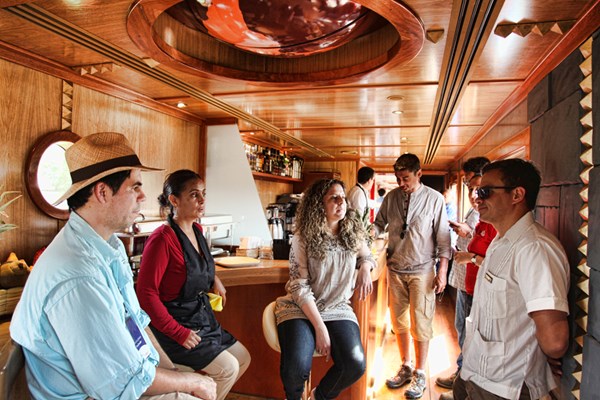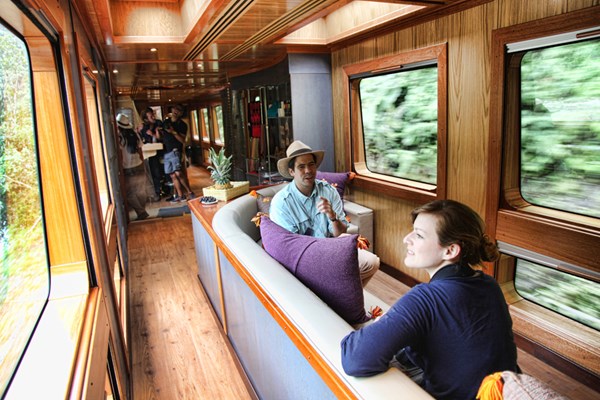QUITO, Ecuador, Aug. 14, 2013 (GLOBE NEWSWIRE) -- Posicionarte, a travel media agency, was invited to discover the brand new Ecuador's cruise train trip 4 days 3 nights from the Andes to Coast, it´s travel editor Andrew Taylor, takes a scenic train ride through the Ecuadorian Andes on Ferrocarrile´s famous "Cruise Train."
The talk of the town in Quito, these days, is a newly restored train line from the highland capital through Humboldt´s Avenue of Volcanoes and on through the cloud forest to the coast. When Andrew received an invitation to ride the train, he browsed around the website, got very excited and then panicked asking himself "What would I wear?".
"I don't often have presentation panic, but then I live in a village on the Ecuadorian Pacific Coast" Andrew explains. Most people wear surf shorts and sandals by day and Andrew says he can make a "dressing-up" statement by putting on a clean shirt and a pair of jeans. The cruise train photographs show colonial and republican dining wagons, sofa studded lounges and a bar. He wondered if he´d need a dinner jacket and bow tie, perhaps a pocket watch on a chain and a burgundy cravat for the cocktail hour.
Andrew tells us "I moved to Ecuador with a backpack and my cat in a box, so there wasn't much hope of that".
The fun of the train is indeed its retro motifs, but the ambience of the scenic train ride in motion is by no means a self conscious affair. It's fascinating! It's really comfortable and passengers mingle with the train staff in a very natural and friendly manner. The main guide is Maria del Carmen Garces, a novelist and alpinista who loves nothing more than to put on her boots and climb a volcano. So there's no script to her rich accounts, as she points out the mountains and tells you about climber´s huts and tales of eruptions, Incan mythology and the rich fauna of the paramo.
The train wasn't always such an elegant ride, and yet since its construction (which began in 1842) the scenery from the train windows will hardly have changed a jot. Back in the day, the train line´s construction was crucially important for the newly formed nation. They had gained independence of a land with three distinct eco-systems: the Pacific coast, the Amazonian rain forest and the Andean volcanic highlands. Sprinkled within this were thousands of small isolated communities, many in very remote areas, whose trade was limited by their lack of transport. The train line linked the coast and the highlands, where previously there was just a very simple donkey path, and the prospect of a very dangerous three week walk. Many people didn´t survive. The train line carried largely trade cargo bringing salt, fish and fruit from the coast and glacial ice, meat and vegetables from the highlands.
The scenic train ride is a four day excursion experience that really gives you a sense of the variety of Ecuadorian culture and its history.
The history of the lands now known as Ecuador isn´t always very easy to swallow, and its modern history doesn´t bear thinking about. Much of the accommodation on the trip is in Spanish Colonial Haciendas and there is a lot of reference to Incan Culture. Of course, both the Incans and the Spanish invaded these lands, and you can´t help feeling exceptionally sorry for the locals, whose life conditions didn´t change much whatever was happening at the wheel of the economy.
This contrast is managed with the utmost respect, a tribute to the sensitivity of the train team and their planning.
Day 1: (Tuesday)
Leaving Quito (2777m) for Cotopaxi National Park they head for the highest part of their trip, Limpiopungo glacial lake at the base of the Cotopaxi volcano. Here, they forgo a lake-side walk for climbing further up the barren Nevada (in a coach) trying to get photos of the volcano from an angle without cloud cover. Barren, breezy and beautiful.
Legend has it that when the Spanish arrived in 1534, the volcano erupted. For the local Panzaleo culture the volcano was their God, and the eruption was taken as a sign to not resist the invasion. The name "Coto"-"paxi" merges the Quichua name for neck and the Mayan word for moon (Neck of the Moon). Every 25 years, on New Year´s Eve, from the altar of Callo, the moon sits perfectly on top of the crater. This occurrence was considered divine.
They lunch at Hacienda San Augustine de Callo, the prestigious home of the great grand-daughter of ex President Leonidas Plaza Gutierrez. Now a hotel, it´s built around an Incan chapel (where llama come running into the courtyard to be fed carrots from a basket.) At Lasso station, there´s a masked folk dance of Mama Negra, mythical clowns and men wearing llama-wool "chaps." It´s a thanksgiving to the sun, the earth and motherhood.
They dine and sleep at the mystical Hacienda Cienega (34 rooms), once a colonial family home and a beef and dairy enterprise, built on a swamp. It´s now owned by 27 cousins. A foreboding entrance of giant, fragrant, Eucalyptus trees reveals a weathered "Manor House" hiding cloisters, a church and an exquisite inner garden around a fountain. Most of the staff are the sons and daughters of the previous domestics and it is both denied and rumoured that it´s haunted. (Andrew asks himself "Was it room 17? I forget.") The talk at the table is ghostly, enhanced by a 15 year old music genius playing three different pan pipes in the same song.
Day 2 (Wednesday)
A visit to a rose plantation proves very interesting. Roses are one of Ecuador´s biggest exports and in the highlands, with rich volcanic soil and proximity to the sun, growth is ten times more productive than anywhere else. The plantation quandaries about the use of pesticides are largely determined by the market vanity for the perfect rose. Nearby in Cayambe (known as plastic valley) there are rose plantations all around. This is causing an environmental disaster consuming more water than the entire capital city of Quito.
After lunch in Ambato (2570m) they trundle up to the remote station of Urbina (3609m) to meet the self-defined "Last Iceman of Chimborazo Volcano."
Balthazar Ushca Tenezaca (79) tells us how, all his life, twice a week. He has climbed up to the glacier (praying) with a donkey and returns with ice. Nowadays, only two markets will buy the ice given the competition from refrigerators. His face is full of life, his teeth yellowed but his spirit untarnished. Of course, the gradual disappearance of the glacier makes it a longer climb every year. The glacier is predicted to disappear altogether in 2020. The glacial streams from this volcano feed rivers that feed the Amazon.
They feed and sleep at a top class modern/ rustic hotel called Abraspungo (42 rooms) Here there´s cable TV's, under-floor heating, lush bathrooms and divine mattresses, such comfortable rooms, in fact, that everyone retires to bed early to make the most of them.
Day 3 (Thursday)
At Colta, they visit the first Catholic Church built in South America and then they move up into Guamote, a station town visit a highland, indigenous food market. Here local Quechua de la Sierra people, living in small communities nearby come together to trade their wares each week. It is much the same as it has been for hundreds of years. It is not a jolly market, nor should it need to be. There's a pig and sheep market that´s a bit more fun, but people, to be honest, simply look exhausted. While the arrival of the train brought some interest (mostly from people wanting to get on board and look around) largely as they walk around the market, they are ignored. No eye contact. Indigenous people in Ecuador provide about 70% of the nations' basic food supplies. Most still live in absolute poverty. Later, they "do" the devil's nose, "the most difficult train passage in the world" requiring the train to zigzag in forward and reverse down a very steep slope. They stay at Eterna Primavera (37 rooms). They dine outside by the pool listening to a marvellous salsa singer.
Day 4 (Friday)
The next stretch is from 1255m to sea level through cloud forest and coastal plains. They meet a tribe of the Shuar indigenous nation, who welcome us with a ritual to cast away evil spirits. The children perform a spectacular hunting dance. At 13 years old, Shuar boys become hunters by ritual and spend a month alone in the jungle, where every animal, plant and river is a spirit. They lunch at a cacao plantation.
The train then chatters right down the middle of a main street, accompanied by security escorts, hooting horns and pedestrians cheering and waving at us. They feel as though they are adored royalty, swept away with the excitement and National Pride. The diesel motor is then changed for a steam train and they chug away to our final destination, Duran, bordering the largest city in Ecuador, Guayaquil. A band comes aboard and for an hour everyone is doing the conga dance through the wagons of the train.
The Andes Scenic train ride costs $990 all inclusive for a four day trip that is an education for life. Do it! It deserves to be done! And what should you wear? Well, it's really not all about that is it!
Photos accompanying this release are available at:
http://www.globenewswire.com/newsroom/prs/?pkgid=20477
http://www.globenewswire.com/newsroom/prs/?pkgid=20478

